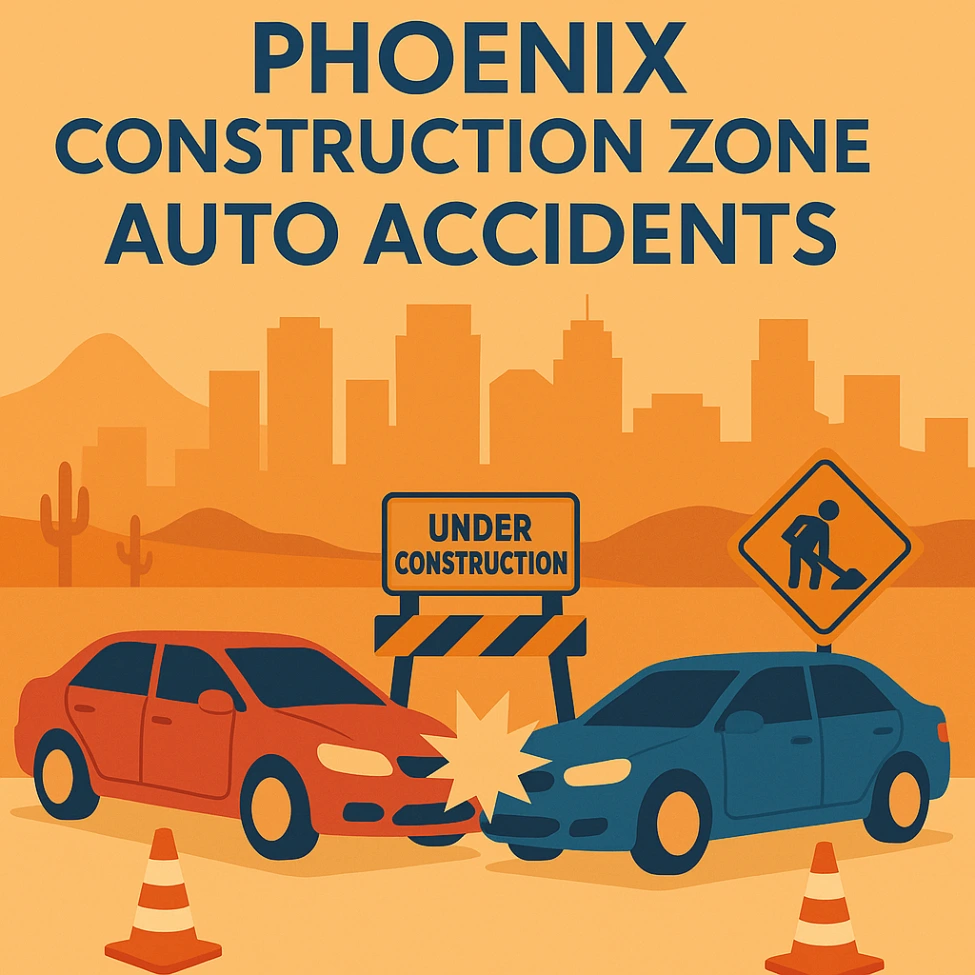Introduction to Construction Zone Liability in Arizona
Construction zones on Phoenix roadways present unique hazards and complex liability issues. As a legal professional analyzing these cases, it’s critical to understand the heightened duty of care, specific statutory frameworks, and the multiple parties who may bear responsibility when accidents occur within work zones.
Applicable Arizona Statutes and Regulations
A.R.S. § 28-710: Enhanced Penalties
This statute specifically prohibits drivers from exceeding temporarily posted speed limits in construction zones, regardless of whether workers are present. Violations result in doubled civil penalties, creating a strong legal presumption of negligence in accident cases involving speeding defendants.
A.R.S. § 28-650: Traffic Control Devices
This statute mandates proper signage and traffic control in construction zones. Construction companies and government entities must comply with the Manual on Uniform Traffic Control Devices (MUTCD), which establishes national standards for work zone safety. Violations can establish negligence per se in liability determinations.
Occupation Safety and Health Administration (OSHA) Regulations
Construction companies operating in Phoenix must comply with OSHA requirements. Non-compliance can serve as powerful evidence of negligence when construction zone conditions contribute to accidents.
Multi-Party Liability Analysis
Construction zone accident cases frequently involve multiple potentially liable parties:
1. Negligent Drivers
The most common causes of driver liability include:
- Speeding in work zones (doubled fines indicate legislative recognition of heightened danger)
- Tailgating (leading to rear-end collisions, the most common type in work zones)
- Distracted driving
- Failure to obey temporary construction signage or traffic directors
- Improper merging in lane closures
2. Construction Companies
Contractors may be liable for:
- Inadequate or missing signage
- Improper traffic control implementation
- Poorly designed detours or lane closures
- Equipment or materials left in travel lanes
- Inadequate worker training
- OSHA violations
3. Government Agencies
State and municipal entities responsible for roadways may face liability for:
- Improper oversight of contractors
- Dangerous road design in construction areas
- Failure to address known hazards
- Inadequate inspection protocols
Note: When pursuing claims against government entities, attorneys must be aware of notice requirements under A.R.S. § 12-821.01, which mandates filing a notice of claim within 180 days.
Causation and Damages in Construction Zone Cases
Construction zone accidents in Phoenix frequently result in severe injuries due to:
- Confined spaces with limited escape routes
- Presence of heavy equipment
- Uneven road surfaces
- Unexpected lane shifts or closures
When building cases, attorneys must establish:
- The specific duty of care violated (statutory or common law)
- Breach of that duty
- Direct causation between the breach and injuries
- Quantifiable damages
Comparative Negligence Considerations
Arizona follows a pure comparative negligence system under A.R.S. § 12-2505. This means plaintiffs can recover damages even if partially at fault, but recovery is reduced by their percentage of fault. In construction zone cases, this frequently involves allocation of responsibility among:
- The injured driver
- Other motorists
- Construction entities
- Government agencies
Recent Case Precedents
Recent Phoenix court decisions have established important precedent for construction zone cases:
- Johnson v. Arizona Department of Transportation (Maricopa County Superior Court, 2023) – Established that inadequate advance warning of lane closures creates presumptive liability for the controlling entity.
- Martinez v. Southwest Contractors (Arizona Court of Appeals, 2024) – Ruled that construction companies have an affirmative duty to monitor and maintain temporary traffic control devices throughout the duration of projects.
Evidence Collection and Preservation Strategies
Given the temporary nature of construction zones, immediate evidence preservation is crucial:
- Site photographs before conditions change
- Obtaining construction plans and permits
- Securing traffic control plans
- Identifying witnesses before they scatter
- Preserving vehicle black box data
- Requesting video from traffic cameras or nearby businesses
Insurance Coverage Issues
Construction zone accidents often involve specialized insurance coverage:
- Contractor’s general liability policies
- Professional liability for design professionals
- Commercial auto coverage for construction vehicles
- Builder’s risk policies
- Government entity self-insurance or risk pools
Defensive Strategies Against Common Defense Arguments
Defense counsel typically raises several arguments in these cases:
- The construction zone complied with all MUTCD requirements
- The plaintiff failed to exercise appropriate caution
- Governmental immunity protects certain entities
- Warning signs were adequate but ignored
Effective counter-strategies include:
- Demonstrating deviations from approved traffic control plans
- Using expert testimony to identify deficiencies not apparent to lay observers
- Documenting pattern evidence of similar incidents at the same location
Conclusion: Strategic Approach to Construction Zone Cases
Phoenix construction zone accident cases require a multi-disciplinary approach combining:
- Thorough understanding of specialized traffic regulations
- Immediate evidence preservation strategies
- Knowledge of construction industry standards
- Identification of all potentially liable parties
- Understanding of complex insurance coverage issues
By carefully navigating these complex elements, attorneys can effectively represent clients injured in Phoenix construction zone accidents while holding all responsible parties accountable.



